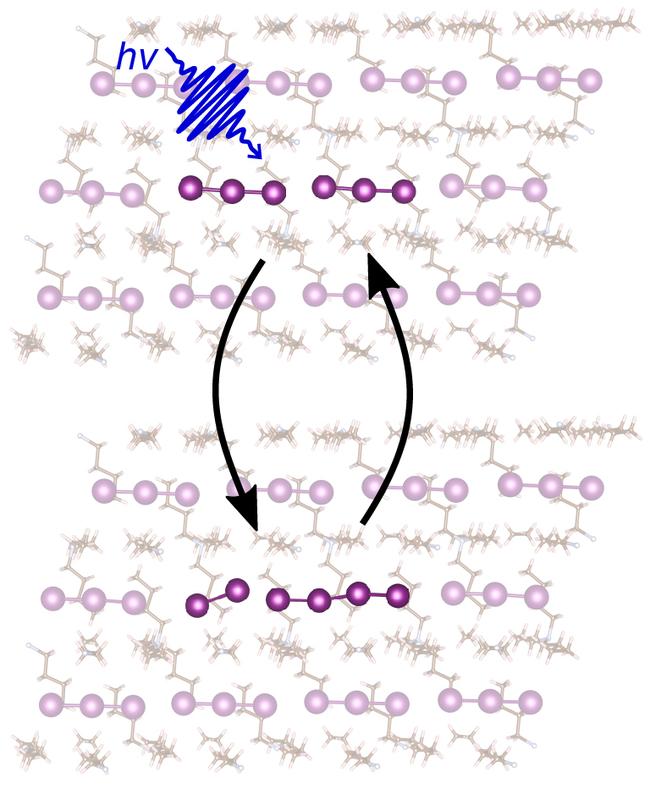Pinball at the atomic level

The picture illustrates the photodissociation of triiodide initiated by a laser pulse and the secondary reaction leading to the novel 4-atom intermediate, followed by the recombination reaction. Image from R. Xian et al. Nat. Chem. (2017), DOI: 10.1038/nchem.2751
The photodissociation of triiodide anion ([I₃]⁻) is a classic textbook reaction that has been extensively studied both in solution and in gas phase. However, probing the ultrafast dynamics of this reaction in the solid state was proven challenging due to partial reversibility of the reaction and its sensitivity to experimental conditions.
Due to an improved sample handling a team of scientists from the MPSD at CFEL and the University of Edinburgh has currently discovered a new reaction intermediate, the tetraiodide radical anion ([I₄]• ⁻), formed as a result of the unique ordering of [I₃]⁻ in the crystal lattice to direct the dissociating I atom – in a process reminiscent of a quantum Newton's cradle. The results have now been published in Nature Chemistry.
In the solution phase, the triiodide anions photodissociates predominantly into iodine radical ([I]•) and diiodide ([I₂]•⁻) radicals. The surrounding solvent plays a passive role in the inertial confinement of the reaction products that ultimately undergo geminate and non-geminate recombination.
In contrast, a dramatically different behavior was found in the ordered ionic lattice of tetra-n-butylammonium triiodide crystals. Here, the local geometry constrains the reaction and, hence, the primary photoproduct, iodine radical ([I]•), is guided by the lattice to form a bond with an adjacent ([I₃]⁻), giving rise to a secondary reaction product, the tetraiodide radical anion ([I₄]• ⁻), not described before for this reaction. As shown in the figure, the reactants are literally aligned in the lattice to form this four-atom intermediate.
“The dissociated iodine atoms collide in a quantum type of a Newton’s cradle with other triiodide molecules to form this novel reaction product” explains Dwayne Miller, and he adds “most importantly, we have demonstrated that lattice can coherently direct the reaction pathway of solid-state photochemistry on femto- to picosecond time scales.”
This phenomenon was only observable thanks to new sample-handling, data collection and analysis techniques developed at the MPSD together with theoretical calculations carried out at the University of Edinburgh to support the electronic and vibrational assignments of the various reaction participants, which enabled the most detailed resolution to date of the reaction intermediates as well as the coherent modes driving the triiodide photodissociation reaction.
“These observations provide a different conceptual framework to think about reaction processes and may point the way in how to couple chemical systems to a bath as a means to increase the length scales under chemical control”, concludes Miller.
http://www.mpsd.mpg.de/en/research/ard/ard – Research website of Prof. Miller
https://dx.doi.org/10.1038/nchem.2751 – Original publication at Nature Chemistry
Media Contact
All latest news from the category: Physics and Astronomy
This area deals with the fundamental laws and building blocks of nature and how they interact, the properties and the behavior of matter, and research into space and time and their structures.
innovations-report provides in-depth reports and articles on subjects such as astrophysics, laser technologies, nuclear, quantum, particle and solid-state physics, nanotechnologies, planetary research and findings (Mars, Venus) and developments related to the Hubble Telescope.
Newest articles

High-energy-density aqueous battery based on halogen multi-electron transfer
Traditional non-aqueous lithium-ion batteries have a high energy density, but their safety is compromised due to the flammable organic electrolytes they utilize. Aqueous batteries use water as the solvent for…

First-ever combined heart pump and pig kidney transplant
…gives new hope to patient with terminal illness. Surgeons at NYU Langone Health performed the first-ever combined mechanical heart pump and gene-edited pig kidney transplant surgery in a 54-year-old woman…

Biophysics: Testing how well biomarkers work
LMU researchers have developed a method to determine how reliably target proteins can be labeled using super-resolution fluorescence microscopy. Modern microscopy techniques make it possible to examine the inner workings…





















